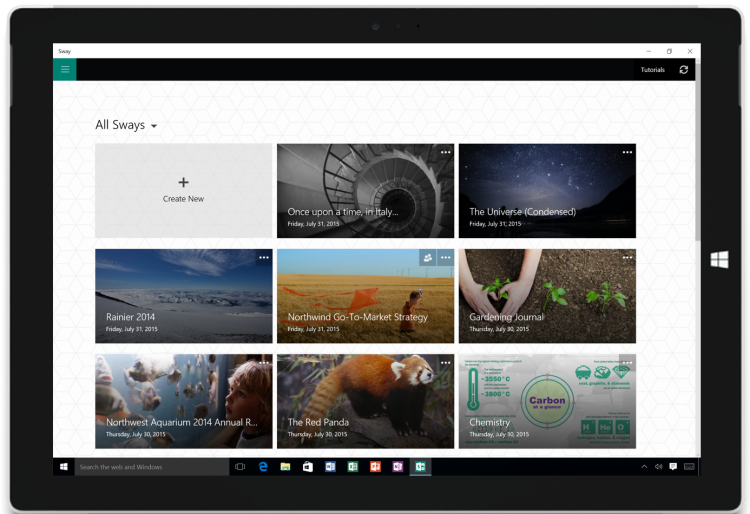Microsoft today announced its content aggregation and presentation application Sway has hit general availability. That means the digital storytelling tool is launching out of preview for consumers and releasing to all eligible Office 365 for business and education customers worldwide. Microsoft is also introducing a Sway app for Windows 10 and revamping Docs.com for sharing not only Sway files, but all Office documents.
Sway launched as a preview in October 2014, becoming the first new app to join the Office product family in years. The premise is simple: Let users create presentations for the Web using text, pictures, and videos, regardless of what device they’re using (phones, tablets, laptops, PCs, and so on).
In fact, Sway’s whole pitch is that you don’t need to know much about design. You provide the ideas and raw content, and Sway’s intelligent design engine creates a polished layout that helps everything flow together “in a way that enhances your story.”
Think of it like PowerPoint with less control over what goes where. We asked David Alexander, who heads the Office technical product marketing team, if he sees a conflict between the two Office apps. “No, we don’t see Sway replacing PowerPoint,” Alexander told VentureBeat.
Presentations are just one of the most obvious Sway use cases. During the preview, Microsoft has seen users create newsletters, training manuals, brochures, vacation recaps, blogs, and even full-blown websites.
Since the preview first arrived, hundreds of thousands of Sways have been created and shared. Microsoft has been taking feedback for the past 10 months and has made a slew of improvements.
Until now though, there was no desktop app. Sway for Windows 10 takes Sway on the Web and adds capabilities specific to PCs and tablets. You can use all of Sway’s integrated content sources and its built-in design engine, but you can also snap photos right into Sway using your computer’s built-in camera, view content offline, and use multiple accounts at once.
Docs.com
Since day one, you could share your Sways directly to Sway.com. But preview users asked for a site that let them share all sorts of files with friends, fans, and the broader Internet. That’s how Docs.com was born.
Microsoft’s docs.com domain was previously used by Docs for Facebook, which as its name implies allowed users to share documents via Facebook. The project was a prototype launched by Microsoft Fuse Labs in 2010. That service has been temporarily moved to fb.docs.com, though Alexander told VentureBeat that “it’s going away.”
Sharing from Sway to Docs.com is straightforward: Tap or click the Share button, and choose to publish directly to the newly relaunched Docs.com. Along with adding support for Sway, Docs.com also supports Word documents, Excel spreadsheets, PowerPoint presentations, Office Mix files, PDFs, and web links.
Docs.com lets you organize your Sways and other Office content into collections. Alexander told us that Docs.com is using Office Online to render all the content, meaning it is shown exactly how it was created: Your documents are not being scaled down to just images.
Microsoft is really hoping Docs.com will become a hub for sharing documents: The service shows you how many views you’re getting and lets anyone post comments on your uploads. You can even create profile pages using just Sway.
Any Sway, document, collection, or profile can be discovered by search engines. In other words, Docs.com not only lets you upload and share content, it also handles all the SEO treatment (Google and Bing) for you.
Availability and requirements
To use Sway, consumers only need a Microsoft account. Just like during the preview, the Office application is free.
Office 365 customers who are part of Microsoft’s First Release program got access to Sway in March. Now business and education customers can use Sway as long as they have an Office 365 plan that includes Office Online, Office 365 Business, or Office 365 ProPlus — the application is being offered to businesses, schools, and other organizations at no extra cost.
Sway on the web works on Microsoft Edge (Windows 10 required), Internet Explorer 10 and up, Firefox 17 and up, Chrome 23 and up, as well as Safari 6 and up. Viewing a Sway on the Web works at any screen resolution, while creating and editing Sways requires a screen width of 600 pixels or higher.
The new Sway app for Windows, which is available in 213 markets, requires Windows 10. That means it is currently only available on PCs and tablets running Microsoft’s latest desktop operating system. You can download Sway for Windows 10 now from the Windows Store.
The Sway team is planning to bring Sway to Windows Phone. The company is targeting a release “in the coming months,” and it will likely require Windows 10 Mobile.
Sway for iPad and iPhone requires iOS 8 or higher, iPad 2 or newer, and iPhone 4s or newer for viewing as well as creating and editing Sways. You can download Sway for iOS now from Apple’s App Store.
The most obvious platform that is missing at launch is Google’s mobile operating system. “We are also working on a native app for Android, so that Sway apps are available on all major platforms and devices consistent with the Office strategy, but we do not have a timeline to share,” a Microsoft spokesperson told VentureBeat.
In short, think of Sway as Microsoft’s PowerPoint built for the online era. While Microsoft doesn’t see PowerPoint going away anytime soon, it’s betting on Sway as the future’s platform for presentations.
VentureBeat's mission is to be a digital town square for technical decision-makers to gain knowledge about transformative enterprise technology and transact. Learn More



